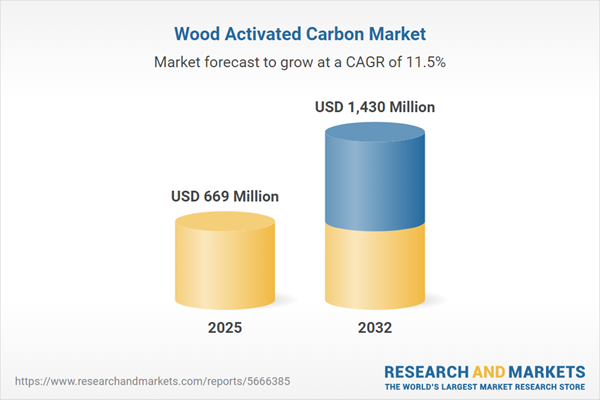Speak directly to the analyst to clarify any post sales queries you may have.
The wood activated carbon market continues to evolve, challenging senior leaders to adapt their procurement and compliance approaches in response to shifting sustainability demands and emerging regulatory drivers. Effective decision-making now demands a nuanced understanding of market complexities, operational innovation, and risk management best practices.
Market Snapshot: Wood Activated Carbon Market
In 2024, the global wood activated carbon market reached USD 600.01 million, with projections showing an increase to USD 669.00 million in 2025 and USD 1.43 billion by 2032. This growth reflects the sector’s response to heightened environmental regulations and the expanded use of sustainable filtration across industries. Organizations in water treatment, air purification, and industrial manufacturing are driving adoption by updating their sourcing and compliance strategies to keep pace with evolving standards and operational priorities in a dynamic regulatory context.
Scope & Segmentation in the Wood Activated Carbon Market
This report delivers actionable insights for executives shaping resilient procurement models and advancing sustainability initiatives. The market’s segmentation underscores a complex landscape where application, end use, and technology selection have direct implications for vendor choice, risk profiles, and supply chain stability:
- Application: Gas-phase and liquid-phase purification provide broad contaminant removal, supporting regulatory goals and maintaining reliability in manufacturing and utility operations.
- End Use: Industrial air filtration, chemical manufacturing, food production, pharmaceuticals, cosmetics, and water treatment each introduce distinct performance and compliance metrics, influencing quality assurance and process efficiency.
- Form: Granular, powdered, and extruded variants enhance supply chain agility, simplify logistics, and can be matched to bespoke procurement objectives based on operational demands.
- Origin: Selection between wood, coal, or coconut shell as base material can improve product characteristics, help meet sustainability standards, and align sourcing approaches to larger environmental frameworks.
- Production Process: Both physical and chemical activation techniques are evaluated, providing opportunities to manage environmental footprint, vendor selection, and process efficiency for optimized performance.
- Regional Analysis: The Americas, Europe, Middle East and Africa, and Asia Pacific present varying regulatory climates, adoption rates, and supply chain intricacies, requiring tailored regional sourcing and compliance programs.
- Company Profiles: Leading supplier assessments support benchmarking and due diligence, helping organizations ensure procurement practices are robust and responsive to ongoing market transitions.
Key Takeaways for Senior Decision-Makers
- Recent developments in pore structure technology provide more effective tools for addressing contamination challenges and compliance risks.
- Ongoing improvements in carbon activation allow organizations to adapt to new technical standards and evolving regulatory frameworks with greater speed and flexibility.
- Strategic partnerships among producers, regulatory bodies, and research teams are driving efficiency gains in carbon regeneration and supporting an industry-wide shift toward sustainable practices.
- Integrating circular economy methodologies, such as enhanced material traceability and increased recirculation of filtration media, helps promote supply chain resilience and supports compliance with sustainability objectives.
- Regional market advances, particularly in Asia Pacific, open up new procurement options and require flexible sourcing approaches to address shifting local policy landscapes and technological trends.
Tariff Impact: Adjusting Supply Chains Amid Policy Changes
Current proposals to implement tariffs on imported wood activated carbon in the United States are shaping procurement planning and supply chain strategies. In this environment, companies are diversifying their supplier networks, expanding domestic production investments, and examining opportunities for vertical integration to safeguard against future volatility and policy shifts.
Wood Activated Carbon Market: Methodology & Data Sources
Findings in this analysis derive from expert interviews, reviews of scientific literature, proprietary industry databases, and peer-validated sources. This multi-layered approach equips senior leaders with dependable, up-to-date information for effective risk mitigation, compliance, and procurement decision-making.
Why This Report Matters
- Enables executive benchmarking and supports strategic entry or expansion plans focused on regulatory compliance and supply chain resilience.
- Offers guidance to optimize supplier diversification and technology adoption for robust operational performance.
- Equips leadership with thoroughly vetted insights to confidently anticipate and respond to shifts in market conditions and industry regulation.
Conclusion
Senior decision-makers gain the knowledge to strengthen compliance, champion sustainability, and adjust operational models for continued stability as the wood activated carbon market advances.
Additional Product Information:
- Purchase of this report includes 1 year online access with quarterly updates.
- This report can be updated on request. Please contact our Customer Experience team using the Ask a Question widget on our website.
Table of Contents
3. Executive Summary
4. Market Overview
7. Cumulative Impact of Artificial Intelligence 2025
List of Figures
Companies Mentioned
The companies profiled in this Wood Activated Carbon market report include:- Calgon Carbon Corporation
- Cabot Corporation
- Kuraray Co., Ltd.
- Ingevity Corporation
- Jacobi Carbons AB
- Osaka Gas Chemicals Co., Ltd.
- CarboTech AC GmbH & Co. KG
- Donau Chemie AG
- Sinocarbon Co., Ltd.
- Carbon Activated Corporation
Table Information
| Report Attribute | Details |
|---|---|
| No. of Pages | 192 |
| Published | November 2025 |
| Forecast Period | 2025 - 2032 |
| Estimated Market Value ( USD | $ 669 Million |
| Forecasted Market Value ( USD | $ 1430 Million |
| Compound Annual Growth Rate | 11.4% |
| Regions Covered | Global |
| No. of Companies Mentioned | 11 |









